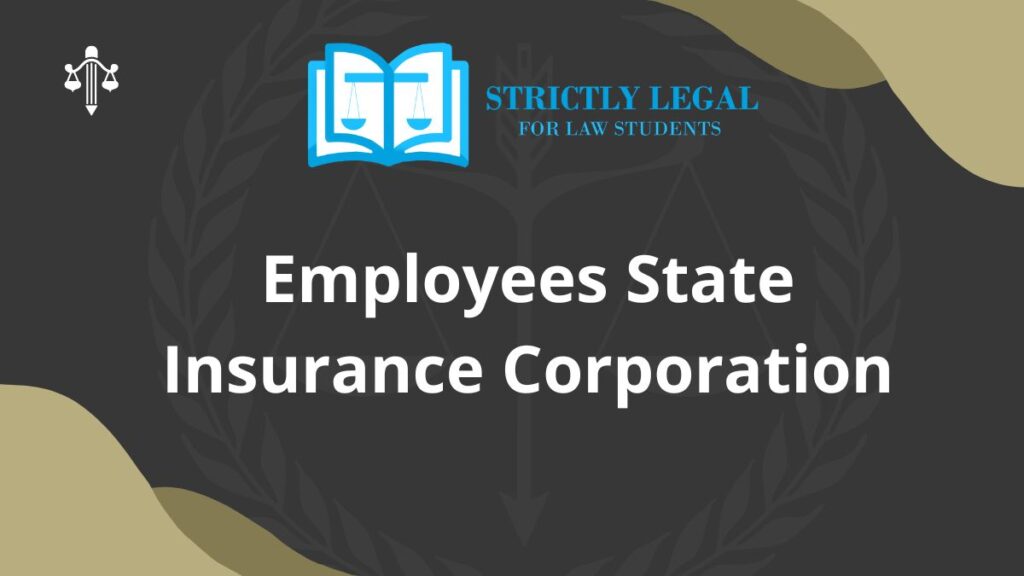The Employees State Insurance Act, 1948 or ESI Act constitutes several sections that skirts various health-related occurrence that the workers generally face I.e., maternity, illness, temporary or permanent disability, and insurance for all those employees who work under factories registered with the ESI Corporation.
Table of Contents
ESTABLISHMENT OF EMPLOYEES STATE INSURANCE CORPORATION
The Employees State Insurance Act, 1948 is a regulatory body under the proprietorship of “The Ministry of Labour And Employment”, Government of India, and was established by Jawaharlal Nehru. It was launched on February 24, 1956, and can be easily accessed at http://www.esic.nic.in/.
The ESI act, perhaps, is the first such act of Parliament that threw light on the social security of the workers.
UNDERSTANDING THE SOCIAL SECURITY BENEFITS
Section 6 of the Employees State Insurance Act, 1948 foresees the following six “social security” benefits:
- Medical Benefit: An insured person and his entire family is given complete medical care from the day he enters insurable employment. There is no roof or bar on the expenditure on the treatment of the Insured Person or his family.
- Sickness Benefit: This benefit is in the form of damages provided in cash at the rate of 70 percent of wages payable to insured workers in the course of certified sickness for the most of 91 days in a year.
- Maternity Benefit: Maternity Benefit for self-confinement or pregnancy is payable for twenty-six weeks, which might be extended for another month on medical advice at the rate of complete salary or wage subject to their endowment of 70days in the foregoing two contribution periods.
- Disablement Benefit: Temporary Disablement benefit is payable at the rate of 90 percent till the disability continues from the day of entering the “insurable payment” disregarding the involvement in case of injury. In the case of Permanent Disablement, the benefit is paid at 90 percent of the wage every month pertaining to the extent of loss of earning capacity which is to be certified by the Medical Board.
SCHEMES UNDER THE ESI ACT
- Rajiv Gandhi Shramik Kalyan Yojana: An insured person if becomes unemployed after his insured period of two to three years, due to factory shut down, retrenchment, or situations like permanent invalidity are entitled to medical care for self and family from ESI hospitals or dispensaries and vocational training is to be provided for self-improvement.
- Atal BeemitVyakti Kalyan Yojana: It is specifically for the employees who are covered under Section 2(9) of the ESI act for providing of relief payment up to 90 days.
CONSTITUTIONAL VALIDITY OF THE ESI ACT
The Employees State Insurance Act, 1948 or ESI Act serves as a “constitutional instrument” for its implementation of getting insurance and medical benefits. The ESI act, however, is worked upon through the ESI corporation, but the Central Government takes control of a most number of the proceedings.
CONSTITUTION OF EMPLOYEES’ INSURANCE COURT
Through a notification in the Official Gazette, an Employees’ Insurance Court will be formed or constituted by the State Government with a bench of judges pertaining to the decision of judges. The same Court might be appointed to two or more local areas. This Court will function with and as the same powers as that of a Civil Court.
DIFFERENCE BETWEEN WORKMEN COMPENSATION ACT AND EMPLOYEE COMPENSATION ACT
| WORKEMEN COMPENSATION ACT | EMPLOYEE COMPENSATION ACT |
| Insured party is termed as workman or workmen in the act. | Insured party is termed as employee or employees in the act. |
| Basic owing amount is INR 80,000. | Basic owing amount is INR 1,20,000. |
| Damages for Permanent disability is INR 90,000. | Damages for Permanent Disability is INR 1,40,000. |
| Medical Treatment expenses are not reimbursed. | Medical Treatment expenses can be reimbursed if any damage happens during the course of employment. |
| No time limit for claim settlements. | Claim settlements must be done within three months from the announcement. |
DUTIES OF THE EMPLOYER IN EMPLOYERS STATE INSURANCE CORPORATION
- An Employer must apply in Form 01(available in the website written above in this article), for damages coverage provided in the ESI Act within a period of fifteen days after the act applies to the factory or establishment.
- The employer has to submit a “Declaration Form” with regards to all coverable employers of the unit.
- The employer has to submit all the deposits of the contribution of both the employees’ and employers’ as per their specified given rates within 21 days of the next month.
- The Employer has to maintain each and every record or register in order to produce them for verification or inspection to the authorized authority of the corporation.
- An employer will also establish the liability towards ESI dues, while acquiring the proprietorship of a factory or establishment via purchase, gift, lease, licence or anything else as the new owner will be accountable to exude previous liabilities.
FAQs
The Scheme of ESI is a self-financing scheme where the funds are predominantly received out of contributions from the employers and employees owed at a fixed percentage of wages monthly. However, the State governments also support one-eights of the share of the cost of medical benefits.
By logging in to the ESIC portal (website credentials given above), within 15 days from the date of its pertinence to them The employer is believed to sign up, providing factory or Establishment Name, Name of the Principal employer, Bank Account, PAN Car number, use of power in case of a factory, State and region as well as an email address. The employer who is registering will get a user ID and a password via his email. Using the same, he needs to log in to the portal for registration. Automatically a 17-digit code number is generated after a successful registration.
Medical care is also provided to retired and permanently disabled insured persons and their spouses on payment of a token annual

Law student.
Turning legal insights into engaging narratives.





